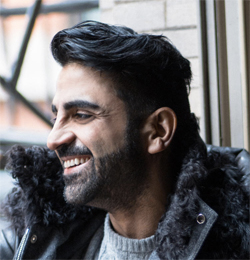New media artist Amir Baradaran awarded two art grants to rethink storytelling and artistic authorship in an age of AR/AI

Amir Baradaran, an art-based researcher in Steven Feiner’s Computer Graphics and User Interfaces Lab (CGUI), has been awarded two grants totaling $220K to create two augmented reality installations, Facing the Cloud + (RE)storing Po{AI}try. Both will be created at Columbia within the CGUI lab.

A winner of the Canada Council for the Arts’ New Chapter Grant (for $120K) and a recipient of the Knight Arts Challenge (for $100K) from the prestigious John S. and James L. Knight Foundation, Baradaran has long been incorporating augmented reality (AR), artificial intelligence (AI), and other technologies into performance art pieces. Even while these technologies were in their early stages, Baradaran saw the potential in AR as a platform for creating immersive, participatory art, where audiences can augment or change an artist’s work.
AR’s implications for storytelling are explored in Facing the Cloud, where audience participants will don headsets to enter into a large-scale immersive installation. Through movements and gestures, they can interact and change the content of what the artist initially created.

“For over 100 years, cinema has conditioned audiences to passively observe a story told in linear time, with every scene tightly scripted and framed by the director and sometimes with input from the actors and other collaborators,” says Baradaran. “AR and AI fundamentally change this equation by allowing the audience to become a co-creator with the artist.”
How AR changes the relationship between art and artist doesn’t necessarily enter into the thinking of the computer scientists and programmers focused on technical aspects of AR. Says Feiner, a pioneer in developing AR technology, “Having Amir here in the lab provides a chance for cross-pollination with artists and others who bring different perspectives. We become better engineers when we’re more cognizant of how these technologies will change the way people interact with the world.”
Facing the Cloud was funded in part by the Knight Arts Challenge matching grant, which according to Victoria Rogers, VP of Arts at the Knight Foundation, “funds the best ideas for engaging and enriching Miami through the arts.” Facing the Cloud will be exhibited in late Spring 2018 in collaboration with the City of Miami’s Little Haiti Cultural Center and with the support of the Smithsonian Affiliate History Miami Museum and the Perez Art Museum Miami (PAMM).
The second project, (RE)storing Po{AI}try, is a large-scale public art project that examines the creative process of code-writing while critically exposing the notion of the presumptive neutrality of code. “Like poetry, code has syntax, symbols, punctuation, spacing, and words,” says Baradaran. “By conceptualizing the language of the machine—that is, code—as Po{AI}try, we can unsettle the disciplinary boundaries between the technologists and artists. Additionally, it helps us question the objective nature of programming as a neutral language. Like poets writing verse, engineers bring their own assumptions, value systems, and lived experiences when they write code.”
(RE)storing Po{AI}try is being funded by the Canada Council for the Arts’ New Chapter project, which was chosen for Canada’s 150th Anniversary Celebrations. Honoring the tradition of oral storytelling and its role in preserving diverse histories of Canada’s First Nations, Baradaran will collaborate with the Awkasasne Mohawk Community in Cornwall, Ontario. Canada
Po{AI}try will be installed at Montreal’s Place des Arts Complex in Fall 2018.
Both Facing the Cloud and (RE)storing Po{AI}try a critical story about the evolving role of augmented reality and artificial intelligence technology. “If AR is to become a new medium for artistic creation, it will require a set of visual and conceptual vocabularies along with technical toolsets for artists to design and implement within this new field,” says Baradaran. “Just as painters have tools like brushes and pigments to express ideas, artists working in AR/AI need theirs.” As the art-based researcher within Feiner’s lab, Baradaran is working directly with engineers and others to provide a common frame of reference and set of functionalities that artists and engineers can use to communicate and co-create.
“It’s really exciting to see the creativity of the arts in collaboration with the creativity of computer science here at Columbia,” says David K Park, Dean of Strategic Initiatives at Columbia University. “The excitement isn’t just about how these fields are working together to push, inform and illuminate the boundaries of virtual reality, AR, and AI as well as other technologies, but how the collaboration creates a richer conversation about how technology is shaping society and just as importantly how society is shaping technologies that we use. I know Amir’s project will engage a broad range of disciplines beyond just the arts and computer science and am excited to see what additional collaborations his work will spark here at Columbia.”
Baradaran is seeking further faculty and student collaborations in 2018. “We are looking for folks interested in mobile application development, Unity/game development, robotics, machine learning and natural language processing,” says Baradaran. He is reaching across campus to form partnerships with faculty members and their students in 2D-3D design, storytelling, journalism, architecture, film, animation, theater performance, acting, and sound production, as well as more theoretical fields such as (art) history, policy, law, and communications.
Those interested interested in learning more can contact amir.baradaran@columbia.edu.
Posted 12/08/17

